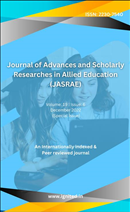Review to the Barriers of Last-Mile Connectivity in Urban Mobility around the Globe
Investigating Barriers to Last-Mile Connectivity in Urban Mobility for Sustainable Transportation
Keywords:
last-mile connectivity, urban mobility, barriers, public transportation, private vehicles, transportation systems, affordable, convenient, mobility options, decongestionAbstract
Transport heralds the economic development of a region and plays a very crucial role in itsurbanization. Urbanization has headed to horizontal development of the cities thus generating problemsof urban sprawl, increase of trip lengths and increased demand of private vehicles which adverselyimpacted on environment. Demand for the public transport sector in Indian cities is increasingcontinuously. To meet these demands, the Government of India has provided a variety of transportationsystems such as the Mass Rapid Transit System (MRTS), Bus Rapid Transit System (BRTS), and LightRail Transit System (LRTS) in every major city. However, the potential of offering affordable andconvenient last mile connectivity (LMC) from the point where a trip finishes to the point where a publictransportation system may be accessed, is mostly ignored and not designed properly, so publictransport riders lag behind. The city has failed to provide inhabitants with fast, comfortable, andeconomical mobility options. In this alarming situation, a rapid paradigm change is required to movepeople away from private vehicles and toward public transportation. Issues with Last Mile Choice canarise for a variety of reasons, including service reliability, waiting times, the lack of direct feeder busroutes, and cost-effective modal interchange options, as well as the quality and facilities available attransit nodes throughout the city. As a result, public transportation has been relegated to a second oreven last choice of mode of transportation. As a result, the number of private vehicles on the road in thecity has been steadily increasing.The purpose of this study towards investigate the barriers of last-mileconnectivity in urban mobility towards decongestion around the globe to identify the mode preferencebehavior of passengers for first and last-mile travel to enhance public transportation and improve thephysical environment for first-to-last-mile connectivity.Published
2022-12-01
How to Cite
[1]
“Review to the Barriers of Last-Mile Connectivity in Urban Mobility around the Globe: Investigating Barriers to Last-Mile Connectivity in Urban Mobility for Sustainable Transportation”, JASRAE, vol. 19, no. 6, pp. 149–154, Dec. 2022, Accessed: Nov. 05, 2024. [Online]. Available: https://ignited.in/index.php/jasrae/article/view/14157
Issue
Section
Articles
How to Cite
[1]
“Review to the Barriers of Last-Mile Connectivity in Urban Mobility around the Globe: Investigating Barriers to Last-Mile Connectivity in Urban Mobility for Sustainable Transportation”, JASRAE, vol. 19, no. 6, pp. 149–154, Dec. 2022, Accessed: Nov. 05, 2024. [Online]. Available: https://ignited.in/index.php/jasrae/article/view/14157









